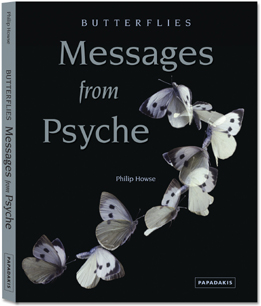by Professor Philip Howse, OBE
300 X 240 mm
192 PAGES IN FULL COLOUR
PAPERBACK
ISBN: 978-1901092-80-6
Butterflies - Messages from Psyche explores the phenomena of visual perception, illusion and reality, unveiling the tangled web that insects weave as they employ colour and pattern to deceive and confuse their predators.
Philip Howse explains how these living tapestries have been designed by evolution to protect insects from their principal predators, which include birds, lizards, monkeys. These insectivores, it is argued, detect their prey by perceiving small details of shape and colour rather than the 'whole picture' of the insect. If we look at the detail of a living butterfly in the way that a bird sees it from many different angles and perspectives, surprising images reveal themselves. There are features of owl eyes, snake heads, caterpillars, lizards, wasps, scorpions, birds' beaks and feathers to be found there. Many butterflies and moths have bizarre combinations of images on their wings and bodies which prompt comparison with the works of art of the surrealists, such as Magritte and Dali. They have a similar effect: to unsettle the way in which things are normally perceived: to confuse and shock. Many of the signs and symbols also resonate within the human psyche, surfacing in our art, architecture, stories and legends.
PROFESSOR PHILIP HOWSE has published several books and numerous research articles on insect behaviour and ecology. He has developed novel environmentally-friendly methods for the control of insect pests, recognised by a number of awards including the OBE. After a career spent mainly at Southampton University, he has now retired but continues writing about the insects that have fascinated him since he was a boy.
 |
The butterfly and moth enthusiast generally has space on their shelves for just one more book and many readers are likely to be enticed by a book that not only focuses on how Lepidoptera have evolved to protect themselves from predators but is also full of surprises. Well, the last thing one would expect to find in a book like this is the story of a bun that looked like Mother Teresa! But, along with many other examples of how optical illusions fool humans, it is not out of place because the author's hypothesis is that what deceives the human eye can also confuse snakes, birds and other enemies of butterflies and moths. The reader is taken on a journey around the world with wonderful illustrations and descriptions of moths and butterflies that emulate the patterns on snakes, on birds' feathers and, of course, eyes.
Much attention is devoted to the latter with fascinating coverage of how images of Lepidoptera have been used in both ancient and modern art. A cave painting dating from 11-14,000 BC possibly depicts an Eyed Hawk moth and must be the earliest moth record! The Death's-head Hawk-moth was frequently included in paintings by Salvador Dali and the stories of folklore beliefs about this moth are truly riveting. It is a book that is hard to put down, exceedingly stimulating and guaranteed to ensure that when looking at butterflies and moths more attention is paid to the reasons why they look like they do.
To order the book visit the Papadakis website